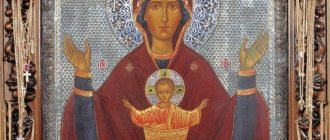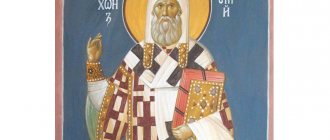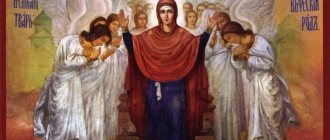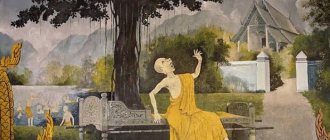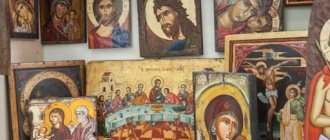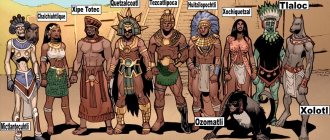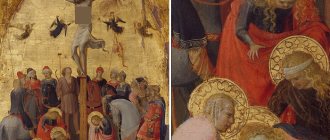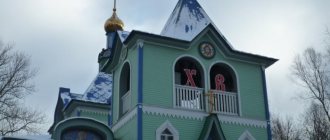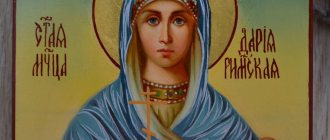For believers, icons act as a mediator between the Divine world and the earthly in individual prayer or in the process of worship. They venerate not the icon itself, but what is depicted on it, attributing magical, healing properties to the picturesque image of God, the Mother of God or the Holy Saints.
Artistically, icons are undoubtedly works of art, impressive in their craftsmanship and the splendor of their rich colors.
Icon painting, as a type of painting with the faces of saints, originated at the dawn of Christianity, and has a history of more than 2 thousand years. In all their diversity, we will present the most beautiful icons, especially revered in Rus' and other Christian countries.
The most beautiful icons in the world:
1
Vladimir Icon of the Mother of God
The miraculous icon, painted according to legend by the Byzantine Luke, was brought to Kyiv in the 12th century. It was a gift from the Emperor of Byzantium to the Russian prince Mstislav.
Having disobeyed his father, Yuri, nicknamed “Dolgoruky” by the chroniclers, went to Rostov and stole it from Vyshgorod, but near Vladimir (as the legend says) the horses transporting the icon stood up and did not want to go further. So it became the main shrine of the Vladimir Assumption Cathedral and received its name, and the city of Vladimir eventually became the princely residence and capital of Rus'.
Now the holy face of Our Lady of Vladimir is in the Church-Museum of St. Nicholas in Tolmachi.
2
The miraculous eruption of the prophet Jonah from the mouth of a whale
The story of the miraculous eruption of the prophet Jonah from the mouth of a whale was described in the Bible. This plot was quite often used to decorate churches, however, it was embodied in an icon only at the end of the 17th century, thanks to the influence of Western European culture.
Mixed media (the whale and background are painted in oil, and the figure of the prophet is depicted in tempera) makes this icon a truly original work of art. It is possible that “The Miraculous Eruption of Jonah from the Whale’s Mouth” was created by two masters. Most likely, the icon was painted in the central part of Russia, since the influence of the capital's understanding of art is felt.
"Trinity"
The work by the great Russian painter Andrei Rublev, painted at the very beginning of the 15th century, is one of the most famous icons of Orthodoxy.
Until 1920, Rublev’s creation was in the Trinity Cathedral of the Trinity-Sergius Lavra. After a short trip to museum churches, in 1929 it firmly settled in the archival collection of the Tretyakov Gallery and is now rightfully considered the “pearl” of Russian icon painting of the art museum.
Let us note that the amazing icon has been renewed several times, and recently the question of returning the “Trinity” to the Lavra has often been raised.
3
Dionysius. Descent into hell. XVI century. Russian Museum.
Dionysius and the workshop.
Descent into hell. 1503. Russian Museum, St. Petersburg. Icon-art.info. Before us is an icon created 80 years after the appearance of Rublev’s “Holy Trinity”. But how much Russian icon painting has changed!
Strict brevity was replaced by detail. The minimum figures were replaced by crowds. A single circular space was divided into several levels. Everything has become much more complicated. Although it has become much more entertaining in terms of looking at the details.
There are angels around Christ. And various demons in Hell. And also a motley crowd of lay people next to the saints.
What was the reason for such dramatic changes in icon painting?
The fact is that 20 years before the “Descent into Hell,” Moscow Prince Ivan III put an end to Rus'’s dependence on the Horde. The country breathed freely.
Both the prince and his close nobles wanted to perpetuate the solemnity of what was happening. After all, Rus' was straightening its shoulders and gaining strength.
It was Dionysius who heard the request and began to create majestic and solemn images. His saints are beautiful, their poses stately. He's already adding more specifics.
This inevitably meant a departure from the sublime spirituality that we saw in Rublev's The Holy Trinity.
But this was the request of society, and Dionysius masterfully followed it.
Tikhvin Icon of the Mother of God
Today there are several lists of this miraculous icon, the work of the Evangelist Luke. Handwritten legends say that the Tikhvin Mother of God first appeared to the world near the town of Tikhvin at the end of the 14th century.
The miraculous salvation of the Tikhvin Monastery in 1613, and of the city itself during the Swedish attack on Russian lands, as well as many other miracles, is associated with it.
One of the most revered icons in the vastness of Russia and the entire Orthodox world is located in the monastery of the city of Tikhvin, and many pilgrims come to look at it.
4
All-Seeing Eye of God
An absolutely atypical icon, striking in its non-standard aesthetics. This is one of the most complex iconographic compositions. The image of the All-Seeing Eye of God was inspired by a quote from the Bible: “Behold, the eye of the Lord is upon those who fear him and trust in his mercy.”
This icon serves as protection from spiritual and physical temptations, allows you to cleanse the stream of consciousness from sinful thoughts, and gives harmony and peace. The icon also helps those who have vision problems.
"Apostles Peter and Paul"
Most likely, this is the oldest work of Orthodox easel painting.
Experts and historians agree that the icon was painted around the beginning of the 11th century in the Novgorod land. It depicts two saints Peter and Paul, one of the most revered Christian saints.
Such was the fate of the icon “Apostles Peter and Paul” that three times during tragic periods of history it had to leave its native Novgorod. But she always returned, and now occupies a place of honor in the Veliky Novgorod Museum-Reserve.
Zvenigorod rank | Author unknown
The image consists of three icons and was discovered in the 1910s. in the barn of the Assumption Cathedral in a city called Zvenigorod. Researchers suggest that it was written around the 15th century.
It depicts the Savior, Archangel Michael and Apostle Paul. All images of saints are presented as sublime and spiritual, their proportions are impeccable.
At first, experts believed that the found relic of the Zvenigorod Chin belonged to the brush of the famous Russian saint icon painter Andrei Rublev, but later they agreed that its author was unknown.
Smolensk Icon of the Blessed Virgin Mary
How and when “Hodegetria” was brought from Greece to Rus' is not known for certain, but based on one of the legends, it can be assumed that she was with Princess Anna, who went to Kiev in 1046 to become the wife of Prince Vsevolod.
Perhaps that is why the icon was a symbol of continuity and friendship between Byzantium and the Russian state. Vsevolod's son Vladimir Monomakh transported it to the city of Smolensk, where he installed it in a newly built church. Since then, the face began to be called the Smolensk Mother of God.
6
The resurrected savior frees the prisoners of Dachau
Bonn icon painter Angela Hauser depicted the day of the liberation of prisoners from the concentration camp. This icon is especially valuable for those who had to endure the horrors of imprisonment.
A huge number of Orthodox people passed through the camp in Dachau, experiencing suffering, deprivation and painful death there. Surprisingly, the American military freed the Dachau prisoners on Palm Sunday, April 25, 1945. Among the prisoners were many priests, monks, and deacons from Mount Athos.
"The Sign of the Blessed Virgin Mary"
The Mother of God on the “Sign” is depicted in full height and with her hands raised in prayer. The baby is registered not in the arms, but on the mother’s chest. This image belongs to the Orant icon painting type.
Miracles began to be attributed to the “Sign” starting in 1170, when the image of the Blessed Virgin Mary helped the Novgorodians. Already in the 17th century, a cathedral was specially built for her.
There was also an amazing fact in the fate of “Znamenie”: in 2009, one of the lists made 176 circles around the Earth on a Russian orbital ship. Upon her return, she again took her place in the Novgorod St. Sophia Cathedral.
7
Manifestation of barbaric paganism
In this attitude towards icons, in my opinion, the pseudo-church mimicry of preserved paganism in our consciousness is manifested. This is a problem for many Orthodox local churches, but perhaps most especially for the Russian Church. At the time of its Baptism, Rus' was not yet at all intellectually ready to accept Christianity. By that time, Slavic paganism had not had time to go through all the stages of its development, flourishing and dying, as was the case with ancient monumental cults. Today, only in books can we learn something about Egyptian spiritualism, Babylonian pantheism, the Olympian gods and the Roman pantheon. There are no real remnants of these cults today. They died. Although there are a few naive romantics who are trying to revive cults long gone into history. But Slavic paganism only managed to go through the stage of its primary emergence. There was no systematic pagan doctrine in Rus' (the so-called “Book of Veles” is an artifact of the 20th century). There was no caste of priests, there were magi, but they cannot be called a caste. A strict cult of pagan worship was not formed. All that is known is sorcery - a set of charismatic improvisations and spells. And we didn’t have any pagan religious buildings. When, for example, we read about Russian pagan “temples” in liturgical texts, this is nothing more than a copy of Greek texts. In this case, the authors did not mean temples in the usual sense for us, but idols, that is, the placement of idols in the open air. Paganism in the popular consciousness did not have time to go through the stages of its development and did not die a natural death in it. That is why pagan magic in a disguised form, alas, continues to live not only among the common people, but even in the minds of many people who consider themselves churchgoers. This is the reason for the occult, pagan utilitarian attitude towards worship, icons and all shrines. Icons are most often worn in wallets and handbags as a kind of talisman, not suspecting that this is a manifestation of sacrilege and barbarism, which is not something new among the people. It is known that in Rus', when they asked God for something, they tried to appease the icon as a pagan idol. Candles and a lamp were lit in front of her, and incense was smoked. And if you were lucky and the wish came true, then the icon was decorated and a beautiful setting was made for it. And if they did not receive what they asked for, then the icon was punished. To begin with, they placed her face to the wall. If things got even worse, they poured boiling oil on them, beat them, and threw them into the slop. And this blatant blasphemy is also a continuation of pagan traditions. Previously, a pagan prince, going on a military campaign, made a sacrifice in the shrine. Returning in victory - with a shield, he brought a thanksgiving sacrifice to the idols, but if on the shield, he could cut the idols with a sword and burn them. As we can see, this savagery is still alive today.
Kazan Icon of the Mother of God
As medieval legend says, “Our Lady of Kazan” was discovered on the ashes of one of the churches after the fire of 1579 in Kazan. And it was found by the girl Matrona, who was ordered to find the shrine by the Mother of God who appeared in a dream.
This image is most revered and loved, and at all times acts as the “Great Intercessor of Russia.” No matter who came to Russian soil with a sword, the holy army invariably prayed to Our Lady of Kazan before significant battles.
The only surviving copy can be seen in the iconostasis of the Kazan Cathedral in St. Petersburg.
The editors of most-beauty.ru advise you to look at the magnificent Orthodox churches of Harbin.
8
"St Nicholas"
Nicholas the Wonderworker has been one of the most revered saints in Rus' since ancient times. That is why his images are distinguished by careful drawing and bright colors.
One of these images is depicted on the so-called Ugresh icon, which, according to legend, appeared to Prince Dmitry during his campaign against the troops of Mamai. The prince ordered the foundation of a monastery on that site, where the image of Nicholas was preserved until 1925.
Now “St. Nicholas” is in the collection of the Tretyakov Gallery, delighting lovers of Orthodox painting who visit the amazing museum.
9
"Spas Eleazarovsky"
This holy image of Christ Pantocrator was discovered in 1352, and the tree from which it was found was laid as the foundation of a temple built on this site. “Spas” is the greatest work of icon painting of the pre-Mongol period, and became the basis for the emergence of a new style that appeared in the 14th century.
Despite the poor preservation of the masterpiece and the need for restoration work, the unique icon was transferred to the Russian Orthodox Church in 2010, but with the condition of not being used in worship.
10
"St. Nicholas the Wonderworker"
The image was created from the famous, especially revered shrine of Mozhaisk wooden sculpture of St. Nicholas the Wonderworker with a sword. Therefore, in sources and colloquially she is also called “Nikola Mozhaisky”.
On the wooden tablet, in addition to the central figure of the saint himself, there is also a hagiography depicting the main miracles of Nicholas. The temple image is interpreted as the main intercessor, patron of both the temple and the city.
After restoration work carried out in the mid-90s of the last century, “Nikola of Mozhaisk” was returned to the Church of the Descent of the Holy Spirit, which is located in Mozhaisk.
11
"Savior Almighty"
“Savior Almighty” or “Pantocrator” (“ruler of everything”) appeared on the territory of Rus' somewhere in the 12th century and became the main prayer icon of all Russian princes.
This is the dominant image in Russian icon painting, and always takes pride of place in churches and temples. Among the miracles, it should be noted that the image of Jesus often streamed myrrh, and there were cases of healing of the afflicted and sick.
12
"Transfiguration"
Painted in 1403, “The Transfiguration of the Lord” was long considered to be the work of Theophanes the Greek, but research in recent decades and the use of the latest technologies have proven that it is the work of an unknown painter.
At that time, the Holy Transfiguration Cathedral was being restored in Pereslavl-Zalessky, and it was to this event that the painting of the image of the son of God was attributed.
Like many other masterpieces of Russian icon painters, “Transfiguration” is in the famous Moscow Tretyakov gallery.
13
Mother of God "Burning Bush".
The Burning Bush - commemorates the unconventional conception of the Savior of this world from the Holy Spirit, and also shows and designates the Mother of God who was born on a sinful earth, but not subject to sin. This spiritual image of the Mother of God is unusual and unique; it differs from the image of the Mother of God familiar to Christians. According to surviving chronicles, this picturesque image first saw the light of day on Greek soil back in 1100. The master or masters who created this icon, unfortunately, remained unknown. Before this icon, you can pray in the same way as before the usual images of the Mother of God on the “Burning Bush” icons, namely: Pray to the Mother of God for help in everyday affairs, ask to strengthen your faith and send good health. This icon protects against fires, thunder and lightning, and protects the homes of Christians from intruders, villains and evil spirits. In Russia, the icon is revered as the heavenly patroness of Russian firefighters. Church celebrations in honor of the Burning Bush icon of the Mother of God take place on September 17.
"Saint Spyridon of Trimifuntsky"
Spyridon, who lived at the end of the 3rd - beginning of the 4th century, is especially revered as a saint of the Christian church. It was he who, speaking at the Ecumenical Council, helped condemn the Arian heresy.
The oldest Greek icon depicting Spyridon has been preserved in the world. Also in the Moscow Church of the Resurrection of the Word there is his face, in the ark of which the relics of St. Spyridon are sealed.
In memory of the great saint, a temple was erected in Moscow during the reign of Mikhail Fedorovich in the name of the saint, and there is a statue of him in Yalta, which stands at the entrance to the temple-chapel of Mikhail Antistratigus.
14
Mother of God "Life-Giving Spring".
The miraculous icon of the Most Holy Theotokos “Life-Giving Spring” gained worldwide fame after it granted healing to all the infirm from the most complex physical ailments and spiritual wounds. The name of the icon speaks for itself, and personifies the salvation of the human soul, both in the literal and philosophical sense, because the Mother of God herself has become a life-giving source for all believers. Before this icon it is appropriate to offer prayers for deliverance from passions and addictions, especially alcohol and drugs. People turn to the spiritual image of the Mother of God in grief and sorrow, which burden the soul, which certainly leads to deprivation of vitality. The Mother of God will always hear the prayer of a believer asking for intercession from worldly temptations and earthly temptations, and will protect a Christian from evil demons who are trying with all their might to take possession of the soul of a believer in order to turn him away from worshiping the Lord. In Russia there are more than a hundred Orthodox churches, many chapels and monastic monasteries, named after the icon of the Most Holy Theotokos “Life-Giving Spring”. The Orthodox Church celebrates celebrations in honor of this icon on every Friday of Easter week.
“Savior in Power” by Andrei Rublev
Another creation of the great Russian master “Savior in the Power”. They helped Rublev in his work on the image of his apprentice, and all this happened in 1408.
“Savior in Power” was written specifically for the magnificent Assumption Cathedral in Vladimir. It is known that the walls of this cathedral were painted by a Russian painter. It is rightfully considered one of the most beautiful in the Orthodox world.
This work by Rublev laid the foundations for a new direction in Russian icon painting, and the masterpiece itself amazes with its grandeur and beauty.
15
"The Golden Robe of the Savior"
Because of the gold frame, which, unfortunately, is now lost, the icon received its luxurious and unique name. “Spas” was written directly for Rus' by a Byzantine master in the 10th century, as indicated by some technical features.
Art critics distinguish this masterpiece from other works by the pose of Jesus and the manner of execution. In Russian soil, the “Golden Robe of the Savior” begins its history in the St. Sophia Cathedral of Novgorod.
In 1700, “Spas” was rewritten and Jesus’ clothes were painted gold to match the title. This amazing face of the son of God has been preserved and can be seen by visiting the Assumption Cathedral of the Kremlin.
Ladder of John the Climacus
The icon depicts a ladder from earth to heaven, along which people in monastic robes are climbing. At the top, Jesus stretches out his hands to those ascending, however, at each of the 30 steps people face trials. The demons try to drag the monks down, and some of them succeed.
This image is an illustration for the book of St. John, consisting of thirty chapters. Each chapter of the book signifies a step on the path to God.
